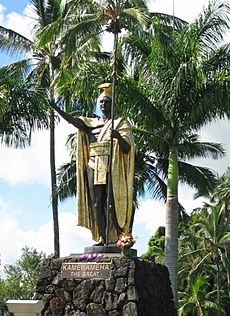Wailoa River State Recreation Area facts for kids
The Wailoa River State Recreation Area is a cool park in Hilo, a town on Hawaiʻi Island in the US state of Hawaii. It's a great place to visit and learn about the island's history and nature.
Contents
What is Wailoa River State Park?
The name Wailoa means "long water" in the Hawaiian language. This park is located right between downtown Hilo, Hawaii and Hilo Bay. You can find it at 19°43′7″N 155°4′30″W / 19.71861°N 155.07500°W.
The main road, Hawaii Belt Road (also called Kamehameha Avenue here), runs along the north side of the park. Next to the Wailoa River bridge, you'll find another park called Liliʻuokalani Gardens. The Wailoa River itself flows a short way from Waiākea Pond inside the park, out to the Pacific Ocean.
Park Size and Features
This park is pretty big, about 132 acres! It is managed by the Hawai'i Department of Land and Natural Resources. The park has a boat ramp, which is a place where you can launch boats into the water. There's also a visitor center with cool displays about Hawaiian culture.
The Wailoa Arts & Cultural Center is also in the park. It opened in 1967 and you can visit for free. It's a good spot to see local art and learn more about the area.
The Kamehameha Statue
Inside the park, you'll see a statue of King Kamehameha I. He was a very important leader who united the islands to create the Kingdom of Hawaii. This statue is not the first one ever made of him, but it's still very special.
Why the Statue is in Hilo
This statue was first planned for a resort on the island of Kauaʻi. But people on Kauaʻi pointed out that their island was the only major one King Kamehameha never conquered in battle. So, the statue was put away in storage.
Later, a group of people who went to Kamehameha Schools raised money. They wanted to move the statue to a better place. In 1997, they brought it to Wailoa River State Recreation Area in Hilo, where you can see it today.
Park History and Tsunamis
The Royal Order of Kamehameha I, a group that honors the king, was worried about where the statue was first placed. They knew that the area near the shore has been hit by huge ocean waves called tsunamis many times.
In fact, the park area used to be a neighborhood in Waiākea. But a giant tsunami hit in 1960. This tsunami was caused by a very strong earthquake in Chile. After the tsunami, the state took over the land in 1969. They turned it into the park you see now.


